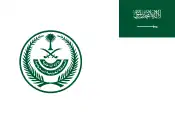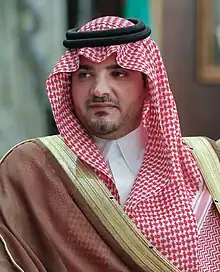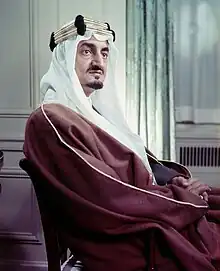Ministry of Interior (Saudi Arabia)
The Ministry of Interior (MoI; Arabic: وزارة الداخلية) is one of the governmental bodies of Saudi Arabia responsible for national security, naturalization, immigration, and customs in Saudi Arabia. It was founded in 1926 by King Abdulaziz, but the organization was reformed in 1951 when the combined ministerial body covering financial and interior affairs were separated.[2][3] The current minister of interior is Abdulaziz bin Saud Al Saud, who has been in office since 21 June 2017.[4]
 Official flag used by the Ministry of Interior | |
 Abdulaziz bin Saud Al Saud, current Minister of Interior since 2017 | |
| Agency overview | |
|---|---|
| Formed | 8 January 1926 |
| Jurisdiction | Government of Saudi Arabia |
| Headquarters | King Fahad Rd, Al Olaya, Riyadh 11543, Saudi Arabia |
| Motto | A homeland we don't protect, we don't deserve to live in |
| Employees | 5000[1] |
| Agency executive | |
| Website | moi.gov.sa |
History
The Ministry of Interior was created in 1926 by King Abdulaziz as a solution to the end of political unrest, tribal conflicts, and statelessness caused by the absence of a powerful central government. The goal of the organization is to serve the citizens and residents of Saudi Arabia, achieving security, stability, and tranquility.
Objectives and Responsibilities
The minister of interior has several objectives and summarizes its mission as follows:
- Achieve security and stability Kingdom-wide, provide tranquility and safety for the citizens and fight against all means of crime to ensure the safety of Saudi society and its development.
- Ensure safety of Pilgrims in order to perform their rituals safely.
- Reinforce security relationships with neighboring Arab countries and cooperate with the Countries of Gulf Cooperation Council (GCC), to maintain safety in the Kingdom and abroad, control crime and drug smuggling, exchange security information, organize citizenship regulations and systems and other miscellaneous issues.
- Reinforce security cooperation with Arab countries to protect cultural possessions and achievements, support internal and external security, control crime, terrorism and drug smuggling and develop Arab security institutions.[5]
Divisions of Internal Security
The history and formation of the MOI and its various sectors passed through phases of administrative development and organization. The ministry consists of the following child agencies:
- MOI Agency for Military Affairs
- Crime Research Center
- General Directorate of Narcotics Control
- General Directorate of Public Security
- Security Forces Organization
- Premises Security Forces Command
- General Directorate of Border Guards
- General Department of Weapons and Explosives
- General Directorate of Civil Defence
- Ministerial Agency of Civil Affairs
.jpg.webp)
- MOI Agency for Security Capabilities
- National Information Center
- Development Projects Center
- General Directorate of the Mujahideen
- High Commission for Industrial Security
- General Directorate of Passports
- King Fahad Security College
- General Directorate of Prisons
- National Center for Security Operations
- Saudi National Central Bureau of Interpol
- General Department of Medical Services
- Special Forces for Security and Protection[6]
List of ministers

- Faisal bin Abdulaziz (1931–1934)
- Abdullah bin Faisal Al Saud (1951–1959)
- Faisal bin Abdulaziz (1959–1960)
- Musaid bin Abdul Rahman Al Saud (1960)
- Abdul Muhsin bin Abdulaziz Al Saud (1960–1961)
- Faisal bin Turki I bin Abdulaziz Al Saud (1961–1962)
- Fahd bin Abdulaziz Al Saud (1962–1975)
- Nayef bin Abdulaziz Al Saud (11 October 1975 – 16 June 2012)
- Ahmed bin Abdulaziz Al Saud (18 June 2012 – 5 November 2012)
- Muhammad bin Nayef Al Saud (5 November 2012 – 21 June 2017)
- Abdulaziz bin Saud Al Saud (21 June 2017 – present)[7]
Aircraft inventory
| Aircraft | Type | Versions | In service | Notes |
|---|---|---|---|---|
| Sikorsky S-70 | Utility/transport helicopter | S-70i | 3[8] | |
| Sikorsky S-92 | Utility/transport helicopter | S-92 | 17 | Some are armed with machine guns |
| Sikorsky S-434 | Training helicopter | S-434 | 9 | Used for training |
| Kawasaki-Vertol 107 | Utility | KV-107IIA-SM-1 | 7 | Used for firefighting |
| Kawasaki-Vertol 107 | Utility/transport | KV-107IIA-SM-2 | 4 | Aeromedical and rescue helicopter |
| Kawasaki-Vertol 107 | Transport | KV-107IIA-SM-3 | 2 | VIP transport |
| Kawasaki-Vertol 107 | Utility/transport | KV-107IIA-SM-4 | 3 | Air ambulance |
| EADS CASA C-295 | Transport | C-295W | 4[9] | |
See also
References
- "Ministry of Interior Company Profile". Ministry of Interior Company Profile.
- James Wynbrandt (1 January 2004). A Brief History of Saudi Arabia. Infobase Publishing. p. 206. ISBN 978-1-4381-0830-8. Retrieved 28 September 2013.
- Hertog, Steffen (2007). "Shaping the Saudi state: Human agency's shifting role in the rentier state formation" (PDF). International Journal of Middle East Studies. 39: 539–563. doi:10.1017/S0020743807071073. Retrieved 17 April 2012.
- "PROFILE: New Saudi Interior Minister Prince Abdulaziz bin Saud bin Nayef". Al Arabiya.
- "MOI Objectives and Responsibilities (Lay your cursor on "About MOI" then click "MOI Objectives and Responsibilities" in order to access.)".
- "Background of the Ministry of Interior of the Kingdom of Saudi Arabia (Lay your cursor on "About MOI" then click "Background" in order to access.)".
- "Background of the Ministry of Interior of the Kingdom of Saudi Arabia (Lay your cursor on "About MOI" then click "Background" in order to access.)". MOI of Saudi Arabia.
- "S-70i Black Hawk in Ministry of Interior".
- "Saudi Arabia orders four Airbus C295W aircraft". airbusdefenceandspace. 16 June 2015. Archived from the original on 24 September 2016.
100